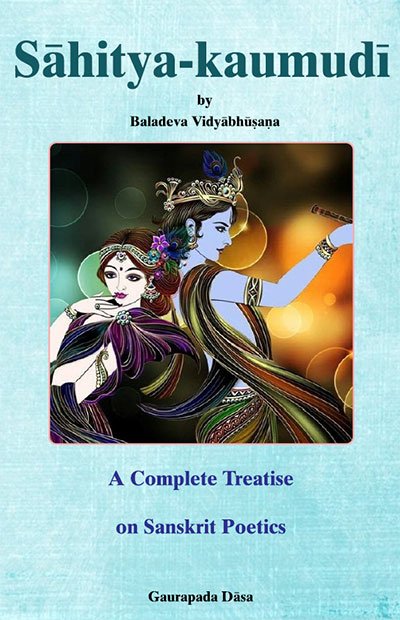Sahitya-kaumudi by Baladeva Vidyabhushana
by Gaurapada Dāsa | 2015 | 234,703 words
Baladeva Vidyabhusana’s Sahitya-kaumudi covers all aspects of poetical theory except the topic of dramaturgy. All the definitions of poetical concepts are taken from Mammata’s Kavya-prakasha, the most authoritative work on Sanskrit poetical rhetoric. Baladeva Vidyabhushana added the eleventh chapter, where he expounds additional ornaments from Visv...
Text 4.6
रस-भाव-तद्-आभास-भाव-शान्त्य्-आदिर् अक्रमः ।
भिन्नो रसाद्य्-अलङ्काराद् अलङ्कार्यतया स्थितः ॥ ४.२६ ॥
rasa-bhāva-tad-ābhāsa-bhāva-śānty-ādir akramaḥ |
bhinno rasādy-alaṅkārād alaṅkāryatayā sthitaḥ ||4.26||
rasa-bhāva—rasa and bhāva; tat-ābhāsa—the semblance of a rasa and the semblance of a bhāva; bhāva-śānti-ādiḥ—is one whose first is bhāva-śānti (the disappearance of a previously prominent vyabhicāribhāva); akramaḥ—[the dhvani which] has no sequence (its sequence is not perceived[1]); bhinnaḥ—different; rasa-ādi-alaṅkārāt—from a literary ornament such as rasavat; alaṅkāryatayā—in terms of being that which is to be embellished; sthitaḥ—situated.
The subcategories of alakṣya-krama dhvani are: rasa-dhvani, bhāva-dhvani (sthāyi-bhāva or single vyabhicāri-bhāva), rasābhāsa-dhvani (semblance of a rasa), bhāvābhāsa-dhvani (semblance of a bhāva) bhāva-śānti-dhvani (the cessation of a vyabhicāri-bhāva), and so on.
The dhvani which takes place as the alaṅkārya is different from rasavat and other alaṅkāras.
ādi-śabdād udaya-sandhi-śabalatvāni. sa cālaṅkāratayā sthito rasādir alaṅkāra-rūpāt tasmād bhinno’saṃlakṣya-kramaḥ. ayam arthaḥ, alaṅkāryo’laṅkāraś ceti rasādir dvedhā. yatra citta-viśrāntidhāmatvād aṅgī tatrālaṅkāryaḥ, sa ca rasa-nirūpaṇe darśayiṣyate. yatra vākyārtho mukhyo rasādir aṅgatvād amukhyas tatra tv alaṅkāro rasavad-ādiḥ, sa ca guṇī-bhūta-vyaṅgya-nirūpaṇe darśayiṣyata iti.
Bhāvodaya (the rise of a vyabhicāri-bhāva), bhāva-sandhi (a mix of vyabhicāri-bhāvas), and bhāva-śābalya (a friction between vyabhicāri-bhāvas) are meant by the word ādi (and so on).
This variety of dhvani, called rasa-ādi-dhvani (an implied rasa, etc.), takes place as the alaṅkārya (it is to be adorned). It is asaṃlakṣyakrama (its sequence is not quite noticed) and is different from a rasa-ādi which has the form of an alaṅkāra (a literary ornament, lit. that which embellishes).
The gist is: There are two kinds of rasādis: alaṅkārya and alaṅkāra. A rasādi is alaṅkārya when it is the aṅgī (the predominant element of the text), inasmuch as it is the locus where the mind finds an exalted repose. That rasādi will be illustrated in the course of expounding the topic of rasa (4.13-56). However, when the literal sense of the text is predominant (in terms of producing astonishment), the rasādi is the aṅga and so is not predominant, therefore at that time the rasādi is an alaṅkāra, such as rasavat. This rasādi will be exemplified in the chapter on second-rate poetry (5.3-9).
Commentary:
The above sūtra explains the meaning of the term rasa-ādi (a rasa and so on). The perception of a rasa is in the category of abhidhā-mūla (based on Denotation) in the sense that the vibhāvas (ālambana, uddīpana), the anubhāvas and the vyabhicāri-bhāvas are expressed with words that have literal meanings: A rasa is implied by means of them.
Footnotes and references:
[1]:
